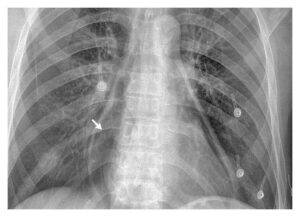This post is an answer to the Case – Painful Left Calf
A 45-year-old man with moderately severe erosive rheumatoid arthritis presented with a several-month history of a painful left calf. He had a 1.5-year history of rheumatoid arthritis affecting both elbows, wrists, metacarpophalangeal joints, proximal interphalangeal joints, knees, ankles and metatarsophalangeal joints.
Examination of the joints revealed diffuse synovitis with bilateral knee effusions and a visibly enlarged left calf with a palpable mass extending inferiorly from the popliteal foss.
The erythrocyte sedimentation rate was 58 mm per hour, and the C-reactive protein level was 37.6 mg per liter. Tests were positive for rheumatoid factor and antibodies against cyclic citrullinated peptide.
There was no evidence of thrombosis on ultrasonography, but an unruptured Baker’s cyst, 16.8 cm by 10.5 cm, was found to be in communication with the joint space.
The symptoms were treated by increasing the patient’s doses of methotrexate and prednisone. At a 6-week follow-up visit, the synovitis was improving, and the cyst was found to be stable, or possibly decreasing, in size.
Baker’s cysts may be seen in patients with rheumatoid arthritis, in whom they consist of a synovium-lined sac that is continuous with the joint space. Symptoms of a Baker’s cyst, especially if it ruptures, may mimic those of venous thrombosis.


